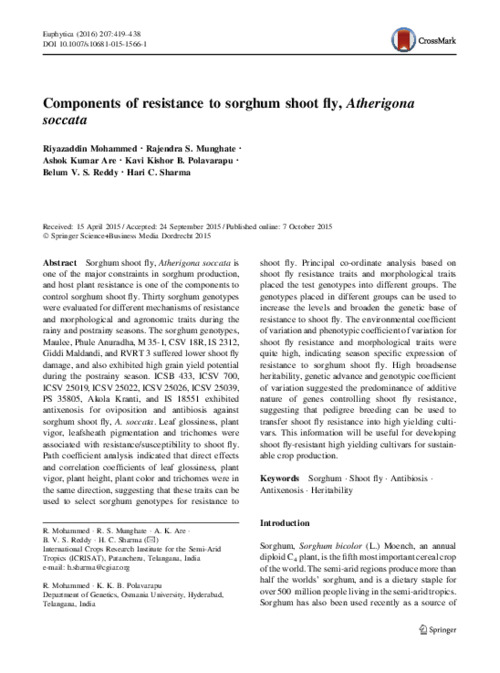Components of resistance to sorghum shoot fly, Atherigona soccata
Abstract
Sorghum shoot fly, Atherigona soccata is
one of the major constraints in sorghum production,
and host plant resistance is one of the components to
control sorghum shoot fly. Thirty sorghum genotypes
were evaluated for different mechanisms of resistance
and morphological and agronomic traits during the
rainy and postrainy seasons. The sorghum genotypes,
Maulee, Phule Anuradha, M 35-1, CSV 18R, IS 2312,
Giddi Maldandi, and RVRT 3 suffered lower shoot fly
damage, and also exhibited high grain yield potential
during the postrainy season. ICSB 433, ICSV 700,
ICSV 25019, ICSV 25022, ICSV 25026, ICSV 25039,
PS 35805, Akola Kranti, and IS 18551 exhibited
antixenosis for oviposition and antibiosis against
sorghum shoot fly, A. soccata. Leaf glossiness, plant
vigor, leafsheath pigmentation and trichomes were
associated with resistance/susceptibility to shoot fly.
Path coefficient analysis indicated that direct effects
and correlation coefficients of leaf glossiness, plant
vigor, plant height, plant color and trichomes were in
the same direction, suggesting that these traits can be
used to select sorghum genotypes for resistance to shoot fly. Principal co-ordinate analysis based on
shoot fly resistance traits and morphological traits
placed the test genotypes into different groups. The
genotypes placed in different groups can be used to
increase the levels and broaden the genetic base of
resistance to shoot fly. The environmental coefficient
of variation and phenotypic coefficient of variation for
shoot fly resistance and morphological traits were
quite high, indicating season specific expression of
resistance to sorghum shoot fly. High broadsense
heritability, genetic advance and genotypic coefficient
of variation suggested the predominance of additive
nature of genes controlling shoot fly resistance,
suggesting that pedigree breeding can be used to
transfer shoot fly resistance into high yielding cultivars.
This information will be useful for developing
shoot fly-resistant high yielding cultivars for sustainable
crop production

